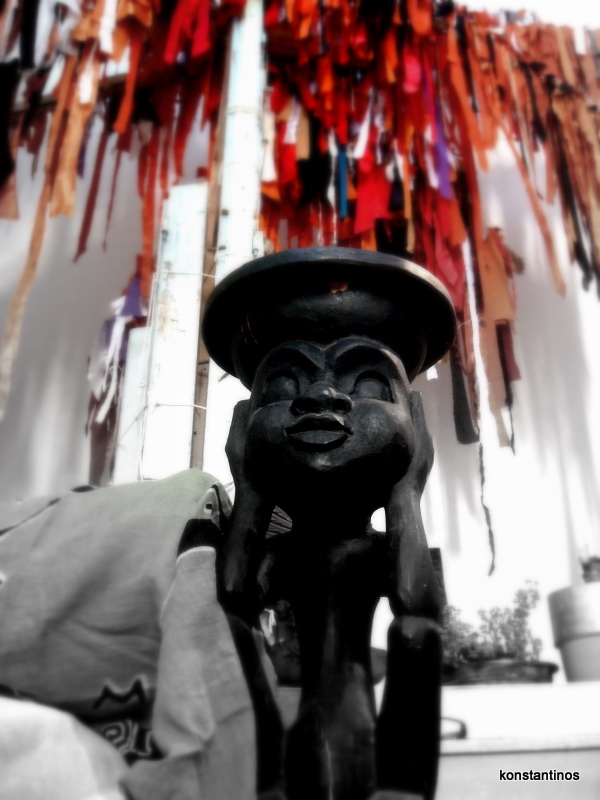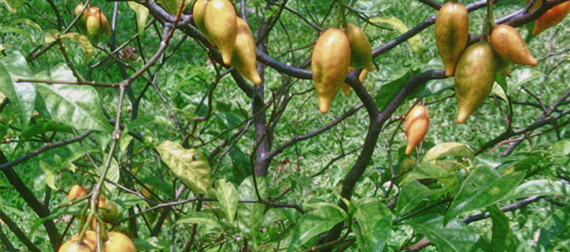A review of the historical, legal and ethical implications of returning control of ibogaine to drug users.
-Howard S. Lotsof
To have or have not is a condition not only related to ibogaine but to all possessions in the commodity driven society in which we live. What makes ibogaine somewhat but not totally unique is that it is a medication, a healing substance. But, that only makes it somewhat unique.
Ibogaine’s true uniqueness may be defined in that it is effective in treating a condition, chemical dependence, where the medical condition and the pharmacotherapy to treat it have both been criminalized in the United States.
Ibogaine
Ibogaine is an alkaloid, a plant derived chemical found in Tabernanthe iboga and some other plants of West Central Africa. It has been used for hundreds of years, possibly longer, in initiation rites of the Bwiti religion principally practiced in Gabon. The botanical source, known to Africans for centuries was identified in Europe in 1889, from samples brought from Gabon in 1864 by Dr. Griffon du Bellay. The alkaloid was isolated from the roots of the plant in 1901 by Dybowsky and Landrin and given the name ibogaine. The Africans referred to it as Iboga or Eboka, hence the naming of the alkaloid. They also called it the “the bitter wood” or “tree of life,” describing its taste and its value in their religious practice.
Between 1905 and the 1950s French researchers suggested ibogaine be used for cardiac atony (weakness of the heart) and neurasthenia, a condition characterized by “general lassitude, irritability, lack of concentration and worry.” It was later used as a central nervous system stimulant throughout the 1950s and thereafter fell into disuse in medical practice. However, its molecular similarity to anticancer drugs attracted both Goutarel and Taylor to study its chemical structure and eventually determine its molecular form. The 1950s saw Ciba pharmacologist Jurg Schneider assess ibogaine’s neuropharmacology, cardiovascular actions and ibogaine’s first documented relationship to opioid drugs when Schneider’s working group discovered that ibogaine would potentiate morphine analgesia as well as, morphine toxicity. Schneider went on to become the President of Dupont’s Biochemical Division.
While this history is certainly brief it brings us to Lotsof’s discovery of ibogaine’s antiaddictive effects in the early 1960s when it was recognized in small focus group that ibogaine attenuated opioid withdrawal due to heroin dependence and concurrently reduced drug craving. Nineteen years later Lotsof would pursue the regulatory development of ibogaine within the FDA, a course of work leading directly to this Ibogaine Roundtable where the discussion of ibogaine’s place in medicine, its control by the medical or user establishment and its place in harm reduction will be discussed.
In The Beginning
In the beginning or as far back as one is able to look, doctors/shamans controlled little more than the life and death of those who entrusted themselves to the members of those professions. No one restricted control of herbal products though the knowledge of their use may have been carefully guarded and there were those who would be more expert in their use than others.
Following the ibogaine experience, whether interpreted as moving through time and space as proposed in the Bwiti religion or simply moving from point to point as in a dream, another characterization of ibogaine, we arrive at 1962. Leary has popularized LSD, Wasson mushrooms and Huxley, the mind in relation to substances altering perception. It is in this context that a drug user focus group while investigating a broad range of drugs discovers ibogaine’s antiaddictive effects. Shortly thereafter, the FDA’s enforcement division, later to become the BNDD blocked further access of the group to chemical industry supplies and the 1960s research period came to a close.
The Present Period

We may say the present period begins in the early 1980s when Lotsof determined to pursue the development of ibogaine as an approved drug. The position of doctors by this time is certainly well est
ablished as to their relationship to patients and pharmaceutical corporations on their part have defined themselves as the gateway for medical drugs.
The question of user control of ibogaine would not be an issue except for the failure of the pharmaceutical industry, the National Institute on Drug Abuse (NIDA) and the medical community to take an interest in an effective treatment to interrupt the chemical dependence syndrome.
The pharmaceutic
al industry has rejected involvement in the development of new therapies to treat substance related disorders for the following reasons: A) They do not view them as profitable; there is a significant liability attached to the patient population that has a mortality rate three to seven times that of the general population; C) companies tend to develop drugs along the lines with which they are familiar [cardiovascular, depression, etc.] and; D) they are reluctant to associate their products with a stigmatized condition and patient population.
The National Institute on Drug Addiction (NIDA) has failed to support ibogaine research and development for a number of reasons. As one NIDA insider indicated, “It is the NIH syndrome, not invented here.” There are very few persons within the NIDA peer review process, the area where grant awards are decided, who have experience with ibogaine or iboga alkaloids. Most of those who would judge the validity of ibogaine and determine to fund studies have backgrounds as opioid medical chemists or opioid pharmacologists and support tends not to be given to new fields of research, as new technologies always have to overcome resistance. Furthermore, funds devoted to ibogaine would not be available for opioid agonist and antagonist research where most of NIDA funding has been spent evaluating opioid dependence therapies. And, like the pharmaceutical corporations themselves, NIDA chooses not to develop new drugs but only to evaluate existing drugs to determine if they are useful in treating dependence to drugs tha
t have an abuse potential. Both the field of science and the determination of which drugs represent abuse potential have been politicized by the Office of National Drug Control Policy (ONDCP). In short, prohibition is determining scientific fields of research and development. All we have to do is look to Galileo to realize very little has changed over the centuries as to the relationship between politics and science.
As for the status of medical doctors causal to the lack of ibogaine, the problem is more systemic than the blame of any individual physician. While there is the possibility of a physician initiated Investigational New Drug Application (IND) being filed with the Food and Drug Administration (FDA) to allow a study drug to be administered to human volunteers to test for safety and efficacy, the medical educational system as a whole teaches that this is not the realm of the practice of medicine and doctors should use only approved medications. This is mandated in education and by law in the United States with few exceptions.
User Control of Ibogaine
If the federal government, the pharmaceutical industry and medical community had either not failed in their responsibility to develop medications such as ibogaine or had not abandoned such responsibility, the question of user control would be moot.
To the drug user trapped in the morass of illegal drug use and adjunct dependence who is searching for relief, ibogaine represents a quick and relatively painless way out. Ibogaine has the ability to transform a dependent drug user to a pre-dependent state, free of physical dependence and drug craving. The transformation that occurs has heretofore been unseen and unknown. The ibogaine paradigm is so new and so unique as to be difficult to perceive, even in concept, except by those who have undergone this rite of passage or observed it firsthand. Pre ibogaine you are dependent on drug use and post ibogaine you are free of the requirement to consume drugs to maintain a state of well-being. In a prohibitionist society it is the difference between societal enslavement and freedom. Under circumstances other than prohibition it would simply be a matter of choice for the individual. It is important to be aware that the reversal of physical and psychological drug dependence is particularly significant in that the drug dependent individual will have for the most part completely lost the ability to conceive of what it is like to not be dependent, so intrusive is the pharmacological effect of chemical dependence. Ibogaine thus allows the user to experience a drug free state of mind that they may not have anticipated experiencing again.
It should be noted that there is no singular position within the drug using community nor even among ibogaine proponents as to who should control the use of ibogaine or if its availability would place other user directed initiatives for heroin prescription or legalization at risk. This uncertainty of where to place ibogaine on the map of drug user activism and medical therapy has not been resolved by drug users, prohibitionists, anti-prohibitionists or the DEA.
In the early 1990s, a period of extreme activism by Dutch and US ibogaine advocates, Lotsof was contacted while in the Netherlands by the DEA desk officer at the US embassy who asked Lotsof to explain why the Dutch government was allowing a demand reduction tool like ibogaine to be researched in the Netherlands? The silence that followed was significant, as Lotsof and the self-help groups had always considered ibogaine to be a harm reduction tool. Lotsof asked the DEA officer what was the basis for his view of ibogaine as a demand reduction tool as Lotsof’s perception was that the Dutch government and researchers viewed it as harm reduction. The DEA officer explained that if what he had read was true and taking into account drug use on a curve relating to the quantity of drugs used by any given number of drug users treated with ibogaine was correct, than he anticipated demand could be reduced by fifty percent and this would seriously hurt the drug cartels by making them easier targets. By the end of the conversation it was obvious to Lotsof that ibogaine was the epitome of both demand and harm reduction. Now the question remained if its development could be moved beyond the reach of government foreign policy and intelligence programs financed by drug money or opposition to new technologies by entrenched scientists? These questions remain unanswered.

Ethics and History
The legislation that has determined our relationship to drugs is based on three principal acts: The Pure Food and Drug Act of 1906, The Harrison Narcotic Act of 1914 and the Controlled Substances Act of 1970. Whether these acts were a result of health or morality or racism or profiteering remains in dispute. The United States and other countries remain deeply divided on the mandates and issues. That being said, these laws and medical practice in the United States have left dependent drug users without legal access to the single most effective substance known to allow the interruption of chemical dependence and to concurrent freedom from abuse by a police apparatus and prison industrial complex.
Believers on both sides of the prohibition argument claim the ethical high ground. Today, a prohibitionist society leaves drug users as an enslaved, abused and stigmatized population, a status hardly different than that of African slaves in America prior to the end of the Civil War. Further, while the death camps of the last Century may be more dramatic, IDU related AIDS deaths leaves us with an image of the treatment of drug users as not distinct from the Nazi’s treatment of Jews, gypsies and others categorized as enemies of the state.
This paper is not a proposal to take action but a discussion of what such action may be and has been. Ibogaine has an activist history of self-help and empowerment similar to that of the Underground Railroad or the struggle to establish needle exchange. Two of the earliest examples of ibogaine activist groups were: 1) The International Coalition for Addict Self-Help (ICASH), established by Bob Sisko whose organization sponsored the initial ibogaine treatments in the Netherlands and 2) Dutch Addict Self-Help (DASH), started by Nico Adriaans and G. Frenken who brought ibogaine directly to drug user communities and fought for access to ibogaine on behalf of their constituencies, petitioning their respective governments to make ibogaine available as an approved medication.
During the very period that this paper was being written an ibogaine underground railroad announced itself over the internet claiming treatment of numbers of drug users in New York City and predicting treatments in other cities. This movement follows the history and ethics of needle exchange and the slave-to-freedom routes of the Underground Railroad as only two examples of the moral imperative that motivates ibogaine advocacy. Based on such history it is evident to the author that religious institutions and the medical community must join with drug users to make ibogaine available to anyone seeking freedom from chemical dependence and to provide those persons with the right to take themselves out of harm’s way.


 Ελληνικά
Ελληνικά